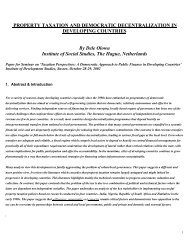View Article - Institute of Development Studies
View Article - Institute of Development Studies
View Article - Institute of Development Studies
Create successful ePaper yourself
Turn your PDF publications into a flip-book with our unique Google optimized e-Paper software.
26State-level centralisation, that is to say, about recentralising tendencies on the part <strong>of</strong> theState government. As mentioned above, there is a view among scholars which attributes,for justified reasons, much importance to the role <strong>of</strong> political parties, <strong>of</strong> party competitionand the pro-poor commitment <strong>of</strong> the ruling party in democratic decentralisation (see theliterature cited in Seshiah, 2003). Some also justify the need for a disciplined party thatwould impose ‘party diktat’ and some degree <strong>of</strong> ideological integrity on local institutionsagainst tendencies towards corruption and other abuses <strong>of</strong> power. But one must recogniseboth the radical as well as the hegemonic potential <strong>of</strong> a highly organised political party,enjoying not just dominance but predominance over a long stretch <strong>of</strong> time.Admittedly, whether or not limits are imposed on the PR system due to the fact <strong>of</strong>their working under a rigid party structure will depend on factors like the nature <strong>of</strong> theparty system, the extent <strong>of</strong> party competition, inner party democracy and so on. Somescholars hold that the CPI(M) party has increasingly organised itself along strong democraticcentralist lines (Bandyopadhyay 1999, Webster 1996). The party asserts a strong controlover its members and supporters, including the members <strong>of</strong> the panchayats. “The grampanchayat’s affairs are discussed by the local party members in closed meetings and theelected supporters are then advised as to how party policy should be carried out throughthe gram panchayat” (Webster, 1996, p. 237). The overwhelming presence <strong>of</strong> the party inthe management <strong>of</strong> local politics and local development, combined with a noticeable dilution<strong>of</strong> its radical ideological commitment, poses a challenge to the autonomous functioning <strong>of</strong>local democratic institutions as well as the local public, especially the poor. 17Moreover, factional quarrels within the party have become more and more manifest.The Left front alliance has grown so wide that as if conflicting class interests are gettinginternalised and erupting occasionally as intra-party rivalries. Indeed, opposition to furtherreforms now come from within the party. 18 The party is caught between the new beneficiarieswho are fearful <strong>of</strong> losing their newly acquired property through more radical land reformsand the landless demanding their share (also see Bandyopadhyay, 2003a). Finally, a quickcomment is in order here regarding the nature <strong>of</strong> party competition in the State. Here,Local Body (LB) <strong>of</strong>fices are filled by multi-party elections; moreover, there are noexceptional allegations <strong>of</strong> fraud or repression. Yet the same party has controlled, withunfailing regularity, an overwhelming majority in the LBs for over nearly three decades.Following Przeworski’s dictum (Przeworski et al. 2000), democracy is a system in whichincumbent parties should lose elections and opposition parties have some chance <strong>of</strong> winning





